COVID-19 Impacts on Whale-Watching Collaboration Networks
Abstract
1. Introduction
2. Materials and Methods
3. Results
4. Discussion
5. Conclusions
Supplementary Materials
Author Contributions
Funding
Institutional Review Board Statement
Informed Consent Statement
Data Availability Statement
Acknowledgments
Conflicts of Interest
References
- Jorge Urbán, R.; Viloria-Gómora, L. Challenges of Whale Watching and Swim with Dolphins in Mexico. Front. Mar. Sci. 2021, 8, 4596. [Google Scholar] [CrossRef]
- Parsons, E.C.M. The Negative Impacts of Whale-Watching. J. Mar. Biol. 2012, 2012, 807294. [Google Scholar] [CrossRef]
- Richards, R.; Meynecke, J.O.; Sahin, O. Addressing Dynamic Uncertainty in the Whale-Watching Industry under Climate Change and System Shocks. Sci. Total Environ. 2021, 756, 143889. [Google Scholar] [CrossRef]
- WHO Coronavirus Disease (COVID-19) Pandemic. 2022. Available online: https://www.who.int/emergencies/diseases/novel-coronavirus-2019 (accessed on 1 September 2022).
- Ostrom, E. A General Framework for Analyzing Sustainability of Social-Ecological Systems. Science 2009, 325, 419–422. [Google Scholar] [CrossRef]
- Rhodes, R.A.W. The New Governance: Governing without Government. Polit. Stud. 1996, 44, 652–667. [Google Scholar] [CrossRef]
- Bodin, Ö. Collaborative Environmental Governance: Achieving Collective Action in Social-Ecological Systems. Science 2017, 357, eaan1114. [Google Scholar] [CrossRef] [PubMed]
- Gruby, R.L.; Basurto, X. Multi-Level Governance for Large Marine Commons: Politics and Polycentricity in Palau’s Protected Area Network. Environ. Sci. Policy 2013, 33, 260–272. [Google Scholar] [CrossRef]
- Berardo, R.; Lubell, M. Understanding What Shapes a Polycentric Governance System. Public Adm. Rev. 2016, 76, 738–751. [Google Scholar] [CrossRef]
- McGinnis, M.D.; Ostrom, E. Social-Ecological System Framework: Initial Changes and Continuing Challenges. Ecol. Soc. 2014, 19, 1–13. [Google Scholar] [CrossRef]
- Adger, W.N. Social and Ecological Resilience: Are They Related? Prog. Hum. Geogr. 2000, 24, 347–364. [Google Scholar] [CrossRef]
- Cinner, J.E.; Barnes, M.L. Social Dimensions of Resilience in Social-Ecological Systems. One Earth 2019, 1, 51–56. [Google Scholar] [CrossRef]
- Biggs, R.; Schlülter, M.; Schoon, M.L. Principles for Building Resilience Sustaining Ecosystem Services in Social-Ecological Systems; Cambridge University Press: Cambridge, UK, 2015. [Google Scholar]
- Berbés-Blázquez, M.; Schoon, M.; Benessaiah, K.; Bennett, E.M.; Peterson, G.D.; Ghimire, R. Resilience in the Times of COVID: What the Response to the COVID Pandemic Teaches Us about Resilience Principles. Ecol. Soc. 2022, 27, 1–25. [Google Scholar] [CrossRef]
- Sachs, J.D.; Karim, S.S.A.; Aknin, L.; Allen, J.; Brosbøl, K.; Colombo, F.; Barron, G.C.; Espinosa, M.F.; Gaspar, V.; Gaviria, A.; et al. The Lancet Commission on Lessons for the Future from the COVID-19 Pandemic. Lancet 2022, 400, 1–57. [Google Scholar] [CrossRef]
- Gössling, S.; Scott, D.; Hall, C.M. Pandemics, Tourism and Global Change: A Rapid Assessment of COVID-19. J. Sustain. Tour. 2020, 29, 1–20. [Google Scholar] [CrossRef]
- CNET Claves Para La Recuperación de La Industria Turística Mexicana. 2021. Available online: https://www.cnet.org.mx/estadisticas-del-sector (accessed on 10 October 2022).
- OECD Tourism GDP (Indicator). 2022. Available online: https://data.oecd.org/industry/tourism-gdp.htm (accessed on 10 October 2022).
- Newsome, D. The Collapse of Tourism and Its Impact on Wildlife Tourism Destinations. J. Tour. Futures 2020, 7, 295–302. [Google Scholar] [CrossRef]
- Spenceley, A.; McCool, S.; Newsome, D.; Báez, A.; Barborak, J.R.; Blye, C.J.; Bricker, K.; Cahyadi, H.S.; Corrigan, K.; Halpenny, E.; et al. Tourism in Protected and Conserved Areas amid the COVID-19 Pandemic. Parks 2021, 27, 103–118. [Google Scholar] [CrossRef]
- Lau, J.; Sutcliffe, S.; Barnes, M.; Mbaru, E.; Muly, I.; Muthiga, N.; Wanyonyi, S.; Cinner, J.E. COVID-19 Impacts on Coastal Communities in Kenya. Mar. Policy 2021, 134, 104803. [Google Scholar] [CrossRef]
- Bennett, N.J.; Finkbeiner, E.M.; Ban, N.C.; Belhabib, D.; Jupiter, S.D.; Kittinger, J.N.; Mangubhai, S.; Scholtens, J.; Gill, D.; Christie, P.; et al. The COVID-19 Pandemic, Small-Scale Fisheries and Coastal Fishing Communities. Coast. Manag. 2020, 48, 336–347. [Google Scholar] [CrossRef]
- Meynecke, J.O.; Richards, R.; Sahin, O. Whale Watch or No Watch: The Australian Whale Watching Tourism Industry and Climate Change. Reg. Environ. Chang. 2017, 17, 477–488. [Google Scholar] [CrossRef]
- Eider, D.; Partelow, S.; Albrecht, S.; Adrianto, L.; Kluger, L.C. SCUBA Tourism and Coral Reefs: A Social-Ecological Network Analysis of Governance Challenges in Indonesia. Curr. Issues Tour. 2021, 1–20. [Google Scholar] [CrossRef]
- Clapham, P. Humback whale: Megaptera Novaengliae. In Encyclopedia of Marine Mammals; Academic Press: Cambridge, MA, USA, 2018; pp. 489–492. [Google Scholar]
- Espinoza Rodríguez, I.J.; Frisch Jordán, A.; Noriega Betancourt, F. Humpback Whales in Banderas Bay, Mexico: Relative Abundance and Temporal Patterns between 2004 and 2017. Lat. Am. J. Aquat. Mamm. 2021, 16, 33–39. [Google Scholar] [CrossRef]
- Rey-Baquero, M.P.; Huertas-Amaya, L.V.; Seger, K.D.; Botero-Acosta, N.; Luna-Acosta, A.; Perazio, C.E.; Boyle, J.K.; Rosenthal, S.; Vallejo, A.C. Understanding Effects of Whale-Watching Vessel Noise on Humpback Whale Song in the North Pacific Coast of Colombia with Propagation Models of Masking and Acoustic Data Observations. Front. Mar. Sci. 2021, 8, 3724. [Google Scholar] [CrossRef]
- DOF. Aviso Mediante el cual se da a Conocer al Público en General la Temporada 2020–2021 Para Llevar a Cabo Actividades de Observación de Ballenas. 2020. Available online: https://dof.gob.mx/nota_detalle.php?codigo=5602280&fecha=09/10/2020#gsc.tab=0 (accessed on 1 September 2022).
- DOF. Norma Oficial Mexicana NOM-131-SEMARNAT-2010, Que Establece Lineamientos y Especificaciones Para El Desarrollo de Actividades de Observación de Ballenas, Relativas a Su Protección y La Conservación de Su Hábitat. 2011. Available online: https://www.dof.gob.mx/nota_detalle.php?codigo=5214459&fecha=17/10/2011#gsc.tab=0 (accessed on 10 October 2022).
- SECTUR Compendio Estadístico del Turismo en México. 2021. Available online: http://www.datatur.sectur.gob.mx/SitePages/Inicio.aspx (accessed on 10 October 2022).
- Langle-Flores, A.; Quijas, S. A Systematic Review of Ecosystem Services of Islas Marietas National Park, Mexico, an Insular Marine Protected Area. Ecosyst. Serv. 2020, 46, 101214. [Google Scholar] [CrossRef]
- Ortega, J.F. Termina La Temporada de Avistamiento de Ballenas Jorobadas En La Región. 2021. Available online: https://contralinea.net/termina-la-temporada-de-avistamiento-de-ballenas-jorobadas-en-la-region/ (accessed on 2 September 2022).
- INEGI Censo de Población y Vivienda. 2020. Available online: https://www.inegi.org.mx/programas/ccpv/2020/#Microdatos (accessed on 2 September 2022).
- Marsden, P.V. Network Data and Measurement. Annu. Rev. Sociol. 1990, 16, 435–463. [Google Scholar] [CrossRef]
- Wasserman, S.; Faust, K. Social Network Analysis: Methods and Applications; Cambridge University Press: New York, NY, USA, 1994; ISBN 0521387078. [Google Scholar]
- Cohen, N.; Arieli, T. Field Research in Conflict Environments: Methodological Challenges and Snowball Sampling. J. Peace Res. 2011, 48, 423–435. [Google Scholar] [CrossRef]
- Laumann, E.O.; Marsden, P.V.; Prensky, D. The boundary specification problem in network analysis. In Research Methods in Social Network Analysis; Freeman, L.C., White, D.R., Romney, A.K., Eds.; Routledge: Oxfordshire, UK, 1989; pp. 61–89. [Google Scholar]
- Langle-Flores, A.; Ocelík, P.; Pérez-Maqueo, O. The Role of Social Networks in the Sustainability Transformation of Cabo Pulmo: A Multiplex Perspective. J. Coast Res. 2017, 77, 134–142. [Google Scholar] [CrossRef]
- Bennett, N.J.; Teh, L.; Ota, Y.; Christie, P.; Ayers, A.; Day, J.C.; Franks, P.; Gill, D.; Gruby, R.L.; Kittinger, J.N.; et al. An Appeal for a Code of Conduct for Marine Conservation. Mar. Policy 2017, 81, 411–418. [Google Scholar] [CrossRef]
- Borgatti, S.; Molina, J. Ethical and Strategic Issues in Organizational Social Network Analysis. J. Appl. Behav. 2003, 39, 337–349. [Google Scholar] [CrossRef]
- Hollstein, B. Mixed methods social networks research: An introduction. In Mixed Methods Social Networks Research: Design and Applications; Cambridge University Press: Cambridge, UK, 2014; pp. 3–34. [Google Scholar]
- R Core Team. R: A Language and Environment for Statistical Computing; R Core Team: Vienna, Austria, 2012. [Google Scholar]
- Butts, C.T. Network: A Package for Managing Relational Data in R. J. Stat. Softw. 2008, 24, 1–36. [Google Scholar] [CrossRef]
- Butts, C.T. Social Network Analysis with Sna. J. Stat. Softw. 2008, 24, 1–51. [Google Scholar] [CrossRef]
- DOF. Acuerdo por el que se Establecen los Lineamientos Técnicos Específicos Para la Reapertura de las Actividades Económicas. 2020. Available online: https://www.dof.gob.mx/nota_detalle.php?codigo=5594138&fecha=29/05/2020#gsc.tab=0 (accessed on 10 October 2022).
- Krackhardt, D. Graph theoretical dimensions of informal organizations. In Computational Organization Theory; Carley, K., Prietula, M., Eds.; Lawrence Erlbaum Associates: Mahwah, NJ, USA, 1994; pp. 89–111. ISBN 080581406X. [Google Scholar]
- Freeman, L. Centrality in Social Networks Conceptual Clarification. Soc. Netw. 1978, 1, 215–239. [Google Scholar] [CrossRef]
- CONANP. Number of Permits Granted to Private Vessels that Visit Islas Marietas National Park; Unpublished data from National Commission of Protected Areas; CONANP: Mexico City, Mexico, 2022. [Google Scholar]
- Bodin, Ö.; Crona, B. The Role of Social Networks in Natural Resource Governance: What Relational Patterns Make a Difference? Glob. Environ. Chang. 2009, 19, 366–374. [Google Scholar] [CrossRef]
- McGee, Z.A.; Jones, B.D. Reconceptualizing the Policy Subsystem: Integration with Complexity Theory and Social Network Analysis. Proc. Policy Stud. J. 2019, 47, S138–S158. [Google Scholar] [CrossRef]
- Ansell, C.; Gash, A. Collaborative Governance in Theory and Practice. J. Public Adm. Res. Theory 2008, 18, 543–571. [Google Scholar] [CrossRef]
- Emerson, K.; Nabatchi, T.; Balogh, S. An Integrative Framework for Collaborative Governance. J. Public Adm. Res. Theory 2012, 22, 1–29. [Google Scholar] [CrossRef]
- Berardo, R. The Evolution of Self-Organizing Communication Networks in High-Risk Social-Ecological Systems. Int. J. Commons 2014, 8, 236–258. [Google Scholar] [CrossRef]
- Alexander, S.M.; Andrachuk, M.; Armitage, D. Navigating Governance Networks for Community-Based Conservation. Front. Ecol. Environ. 2016, 14, 155–164. [Google Scholar] [CrossRef]
- Berdej, S.M.; Armitage, D.R. Bridging Organizations Drive Effective Governance Outcomes for Conservation of Indonesia’s Marine Systems. PLoS ONE 2016, 11, e0147142. [Google Scholar] [CrossRef]
- Wang, P.; Robins, G.; Pattison, P.; Lazega, E. Exponential Random Graph Models for Multilevel Networks. Soc. Netw. 2013, 35, 96–115. [Google Scholar] [CrossRef]
- Cohen, P.J.; Evans, L.S.; Mills, M. Social Networks Supporting Governance of Coastal Ecosystems in Solomon Islands. Conserv. Lett. 2012, 5, 376–386. [Google Scholar] [CrossRef]
- Langle-Flores, A.; Aguilar Rodríguez, A.; Romero-Uribe, H.; Ros-Cuéllar, J.; von Thaden, J.J. Multi-Level Social-Ecological Networks in a Payments for Ecosystem Services Programme in Central Veracruz, Mexico. Environ. Conserv. 2020, 48, 41–47. [Google Scholar] [CrossRef]
- Merkle, C.; DuBois, B.; Sayles, J.S.; Carlson, L.; Spalding, H.C.; Myers, B.; Kaipa, S. Self-Reported Effects of the COVID-19 Pandemic on Stewardship Organizations and Their Activities in Southeast New England, USA. Front. Sustain. Cities 2022, 3, 2880. [Google Scholar] [CrossRef]
- Phua, C.; Andradi-Brown, D.A.; Mangubhai, S.; Ahmadia, G.N.; Mahajan, S.L.; Larsen, K.; Friel, S.; Reichelt, R.; Hockings, M.; Gill, D.; et al. Marine Protected and Conserved Areas in the Time of COVID. Parks 2021, 27, 85–102. [Google Scholar] [CrossRef]
- Quimbayo, J.P.; Silva, F.C.; Barreto, C.R.; Pavone, C.B.; Lefcheck, J.S.; Leite, K.; Figueiroa, A.C.; Correia, E.C.; Flores, A.A.V. The COVID-19 Pandemic Has Altered Illegal Fishing Activities inside and Outside a Marine Protected Area. Curr. Biol. 2022, 32, R765–R766. [Google Scholar] [CrossRef] [PubMed]
- Felbab-Brown, V. Mexico’s Out-of-Control Criminal Market. 2019. Available online: https://www.brookings.edu/research/mexicos-out-of-control-criminal-market/ (accessed on 10 October 2022).
- Spijkers, J.; Singh, G.; Blasiak, R.; Morrison, T.H.; le Billon, P.; Österblom, H. Global Patterns of Fisheries Conflict: Forty Years of Data. Glob. Environ. Chang. 2019, 57, 101921. [Google Scholar] [CrossRef]
- Bernard, H.R.; Killworth, P.D.; Sailer, L. Related Papers Informant Accuracy in Social Net Work Dat a II Informant Accuracy in Social-Network Data V. An Experimental Attempt to Predict Actual Communication from Recall Data. Soc. Sci. Res. 1982, 11, 30–66. [Google Scholar] [CrossRef]
- Borgatti, S.P.; Everett, M.G.; Johnson, J.C. Analyzing Social Networks; Sage: London, UK, 2018. [Google Scholar]
- Everett, M.G.; Borgatti, S.P. Extending centrality. In Models and Methods in Social Network Analysis; Carrington, P.J., Scott, J., Wasserman, S., Eds.; Cambridge University Press: Cambridge, UK, 2005; pp. 57–76. [Google Scholar]
- Freeman, L.C. A set of measures of centrality based on betweenness. Sociometry 1977, 40, 35–41. [Google Scholar] [CrossRef]
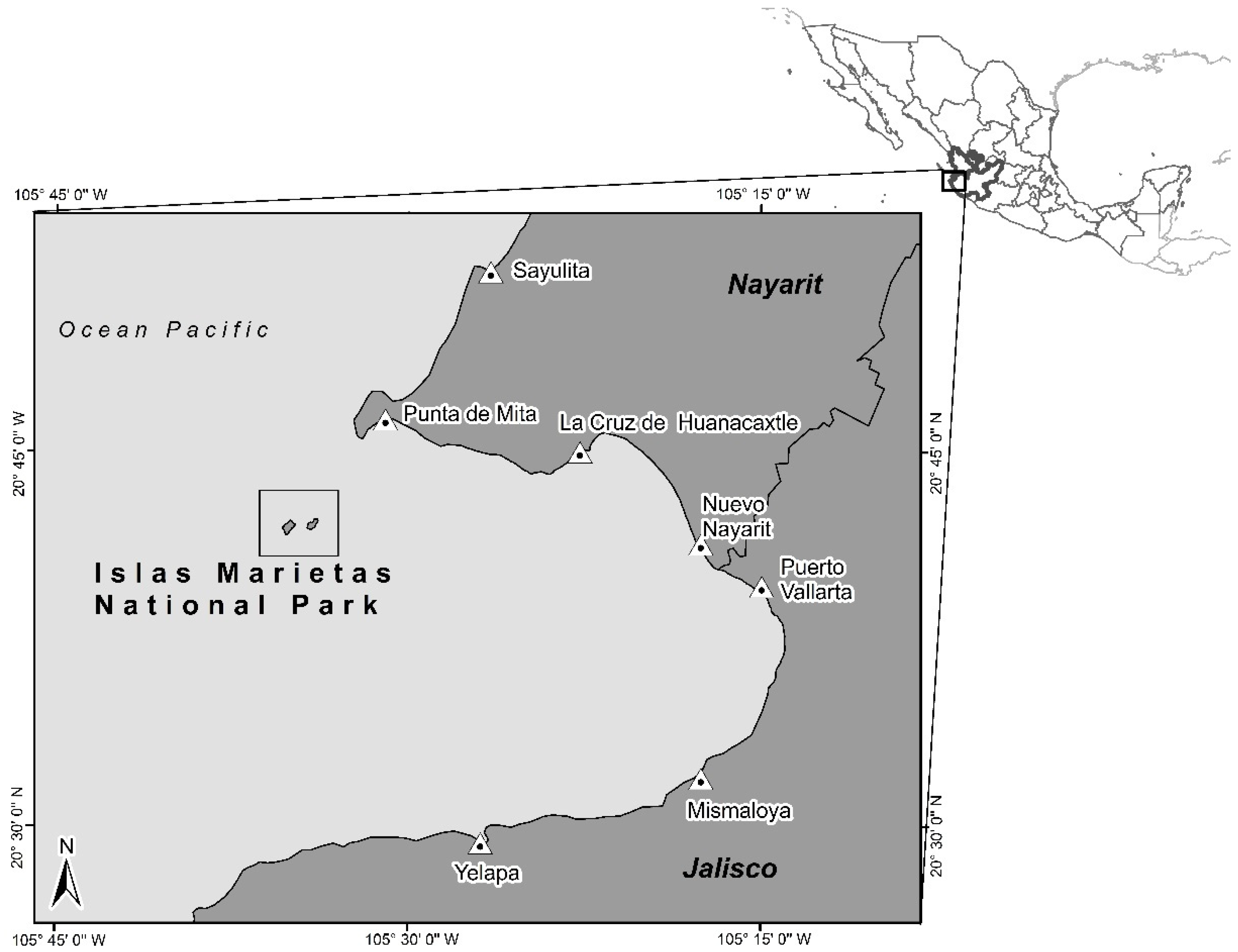
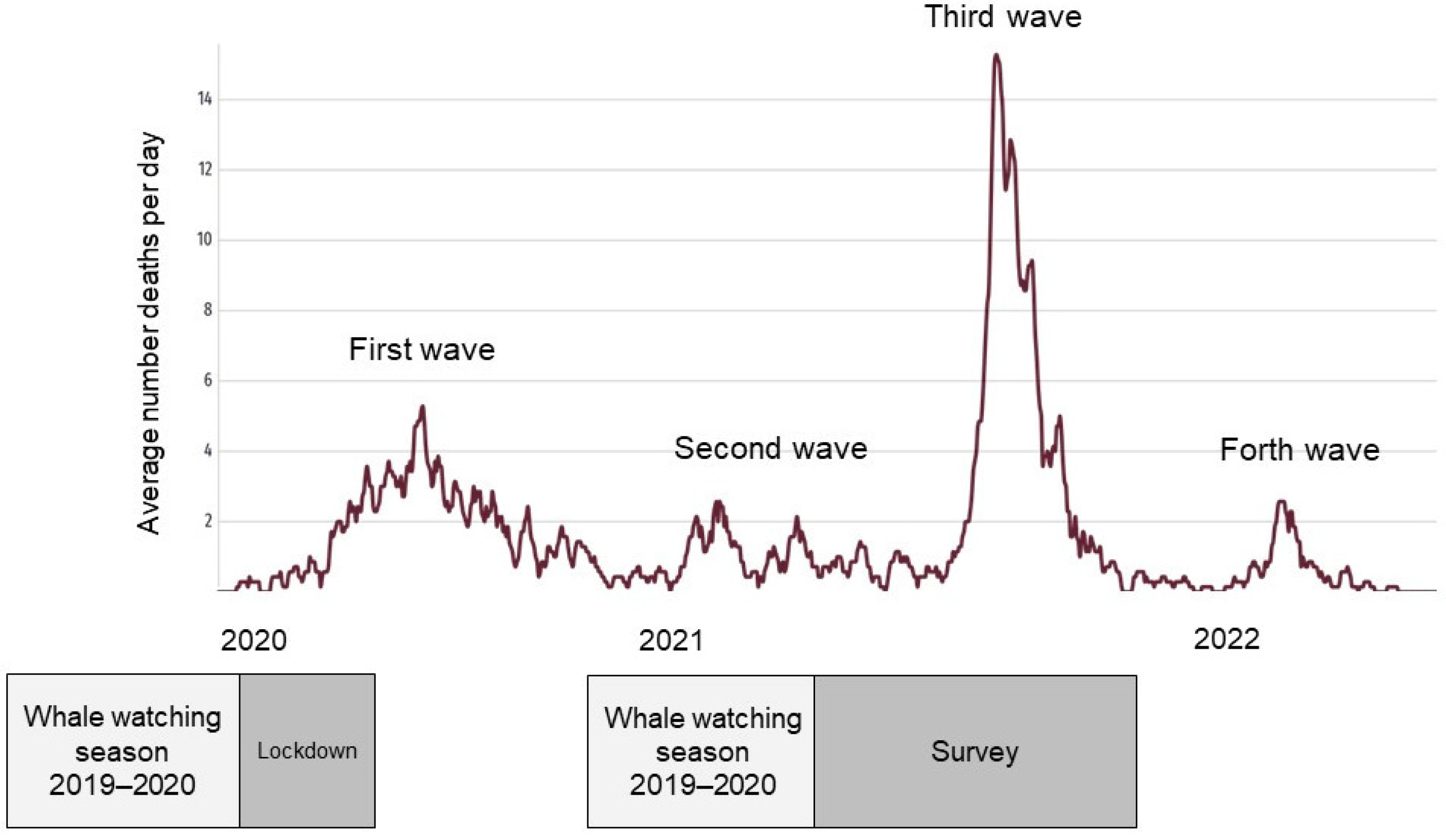
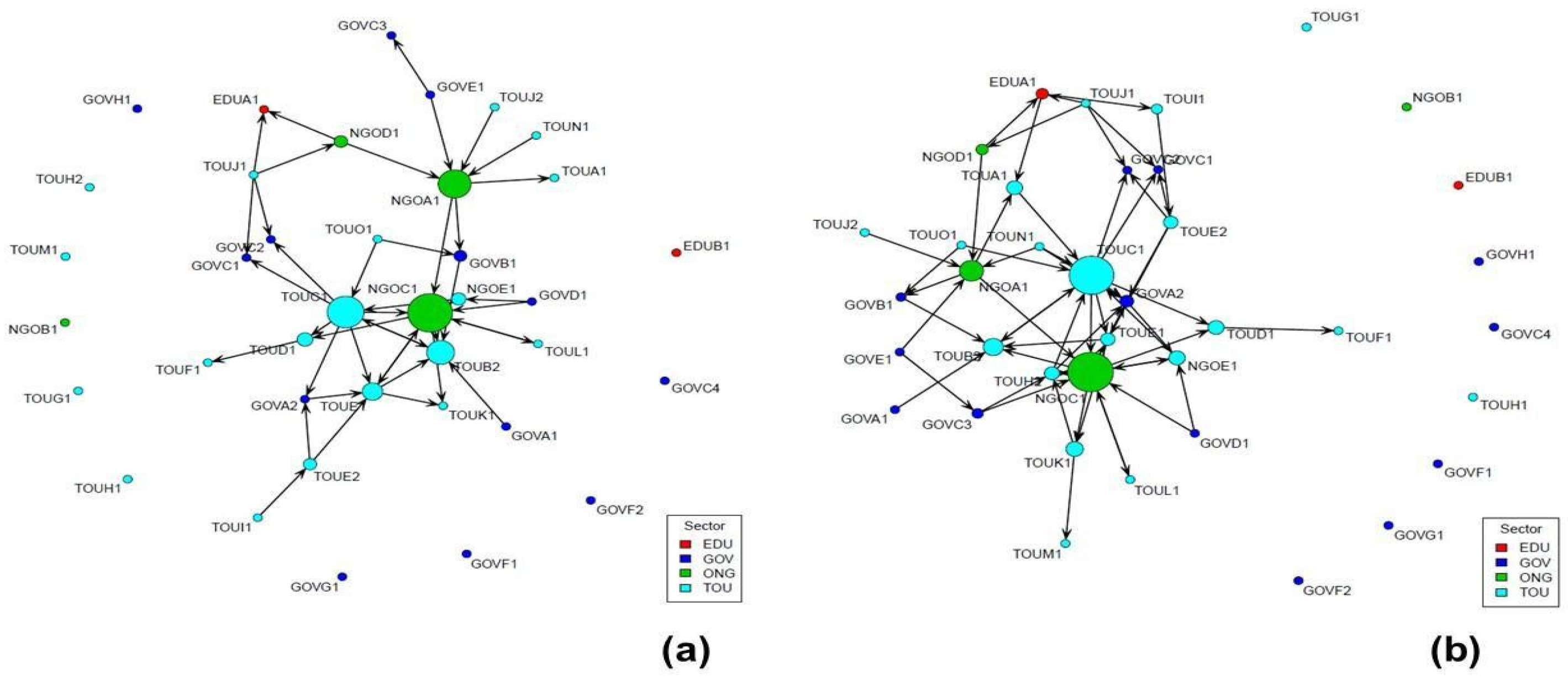
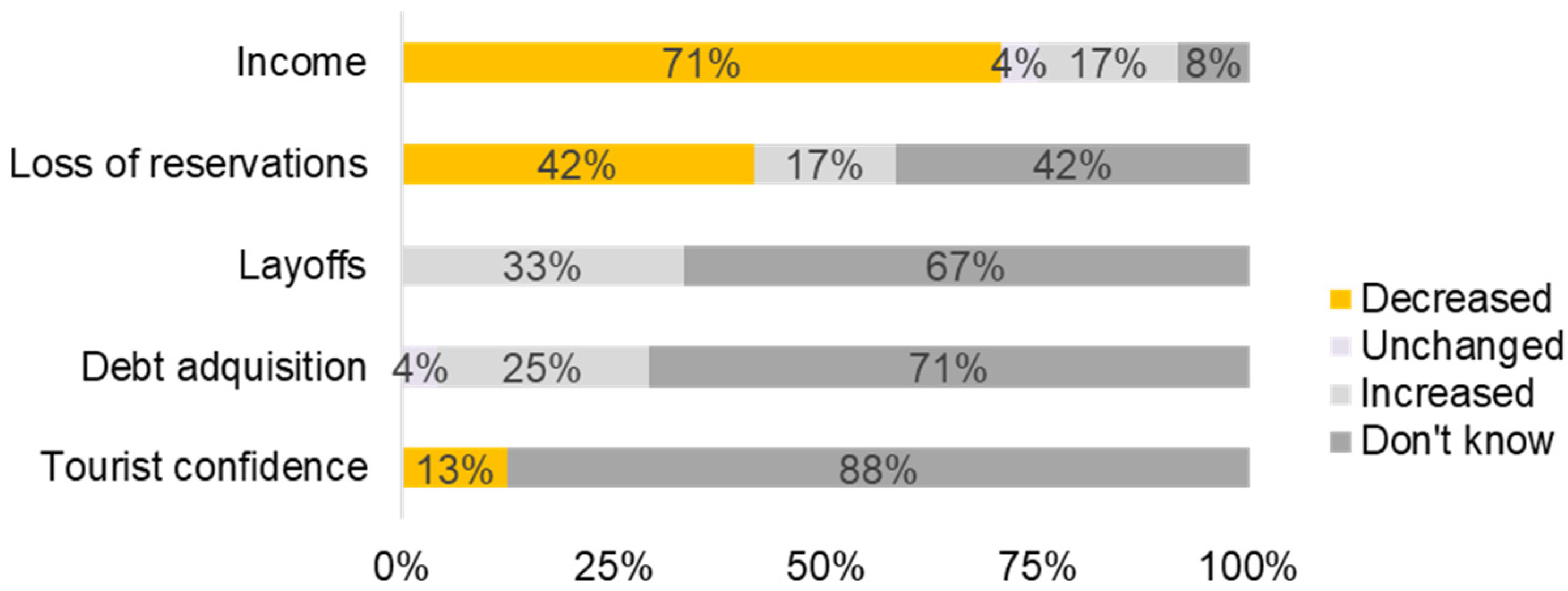


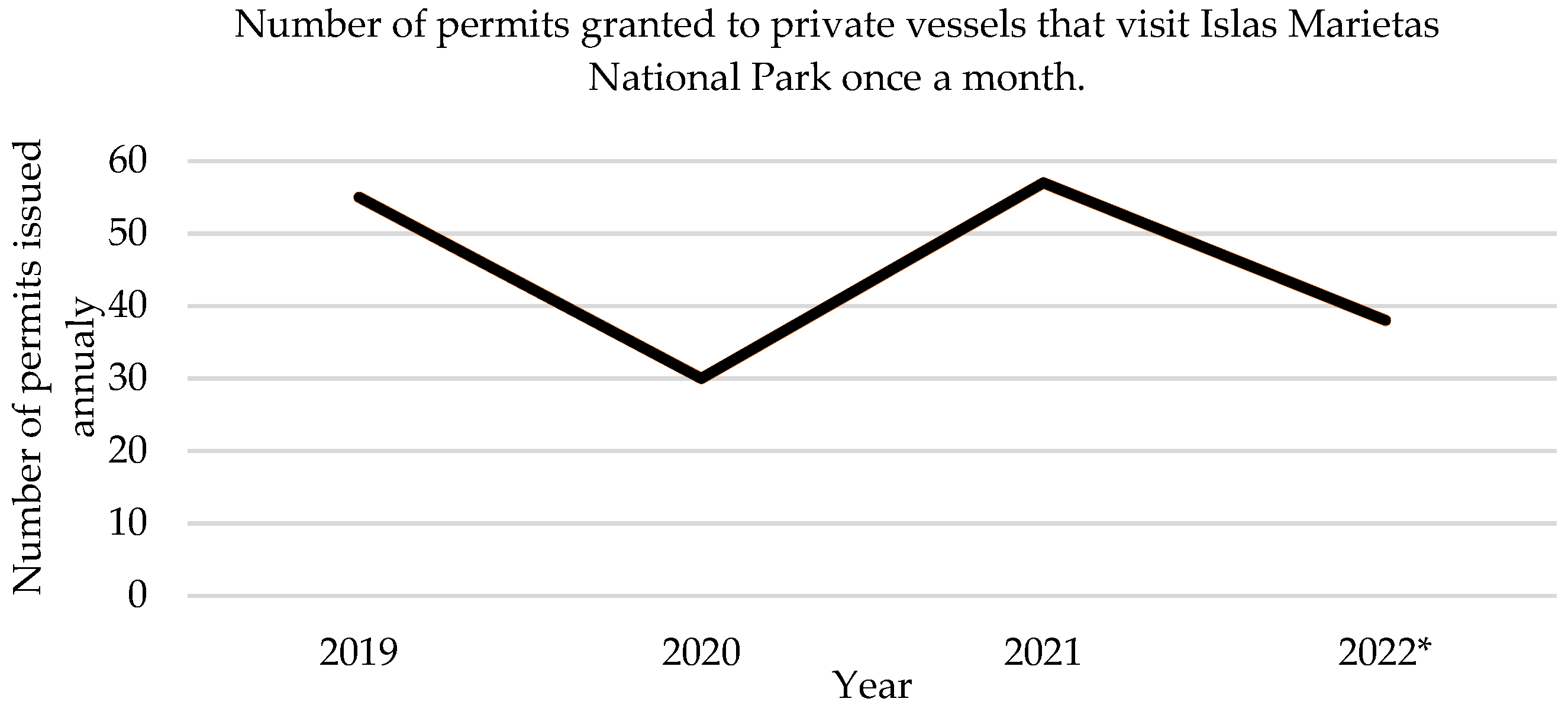
| Organization Type | Number of Interviewees |
|---|---|
| Tour operators | 18 |
| Government | 13 |
| NGO | 5 |
| Education | 2 |
| Total | 38 |
| Location | Number of Interviewees |
|---|---|
| Sayulita, Nay. | 3 |
| Punta de Mita, Nay. | 4 |
| La Cruz de Huanacaxtle, Nay. | 7 |
| Nuevo Nayarit, Nay. | 2 |
| Puerto Vallarta, Jal. | 16 |
| Mismaloya, Jal. | 1 |
| Yelapa, Jal. | 1 |
| Tepic, Nay. | 4 |
| Total | 38 |
| Composition of Collaboration Network by Type of Stakeholder | Before the Pandemic (T 2019–2020) | After the Second Wave of COVID-19 (T 2020–2021) |
|---|---|---|
| Government | 8 | 8 |
| Tour operator | 14 | 16 |
| NGO | 4 | 4 |
| Education | 1 | 1 |
| 27 | 29 |
| Global Property | Before the Pandemic (T 2019–2020) | After the Second Wave of COVID-19 (T 2020–2021) |
|---|---|---|
| Density | 0.03 | 0.04 |
| Connectivity | 0.17 | 0.26 |
| Reciprocity | 0.10 | 0.07 |
| Transitivity | 0.16 | 0.13 |
| Degree of centralization | 0.20 | 0.26 |
| Betweenness centralization | 0.07 | 0.09 |
| Reciprocity | 0.10 | 0.07 |
| Stakeholder | Before the Pandemic (T 2019–2020) | After the Second Wave of COVID-19 (T 2020–2021) |
|---|---|---|
| NGOC1 | 7.67 | 9.53 |
| TOUC1 | 5.97 | 9.22 |
| NGOA1 | 5.11 | 3.88 |
| TOUB2 | 4.03 | 2.80 |
| TOUK1 | 0.00 | 2.10 |
| NGOE1 | 1.15 | 1.85 |
| TOUD1 | 1.43 | 1.80 |
| TOUA1 | 0.00 | 1.79 |
| TOUH2 | 0.00 | 1.53 |
| TOUE1 | 2.44 | 1.38 |
| Type of Self-Reported Economic Impact | Before the Pandemic (T 2019–2020) | After the Second Wave of COVID-19 (T 2020–2021) |
|---|---|---|
| Average no. of weekly tours | 39.4 (116.5) | 17.2 (49.3) |
| Average number of tourists per boat | 10.8 (6.5) | 5.3 (3.1) |
| Average percentage of international tourists per vessel | 54.7 (24.3) | 40 (17.9) |
| Average percentage of domestic tourists per vessel | 45.3 (24.3) | 60 (17.9) |
Publisher’s Note: MDPI stays neutral with regard to jurisdictional claims in published maps and institutional affiliations. |
© 2022 by the authors. Licensee MDPI, Basel, Switzerland. This article is an open access article distributed under the terms and conditions of the Creative Commons Attribution (CC BY) license (https://creativecommons.org/licenses/by/4.0/).
Share and Cite
Langle-Flores, A.; López-Vázquez, Z.; Chávez-Dagostino, R.M.; Aguilar-Rodríguez, A. COVID-19 Impacts on Whale-Watching Collaboration Networks. Sustainability 2022, 14, 13846. https://doi.org/10.3390/su142113846
Langle-Flores A, López-Vázquez Z, Chávez-Dagostino RM, Aguilar-Rodríguez A. COVID-19 Impacts on Whale-Watching Collaboration Networks. Sustainability. 2022; 14(21):13846. https://doi.org/10.3390/su142113846
Chicago/Turabian StyleLangle-Flores, Alfonso, Zinthia López-Vázquez, Rosa María Chávez-Dagostino, and Adriana Aguilar-Rodríguez. 2022. "COVID-19 Impacts on Whale-Watching Collaboration Networks" Sustainability 14, no. 21: 13846. https://doi.org/10.3390/su142113846
APA StyleLangle-Flores, A., López-Vázquez, Z., Chávez-Dagostino, R. M., & Aguilar-Rodríguez, A. (2022). COVID-19 Impacts on Whale-Watching Collaboration Networks. Sustainability, 14(21), 13846. https://doi.org/10.3390/su142113846









